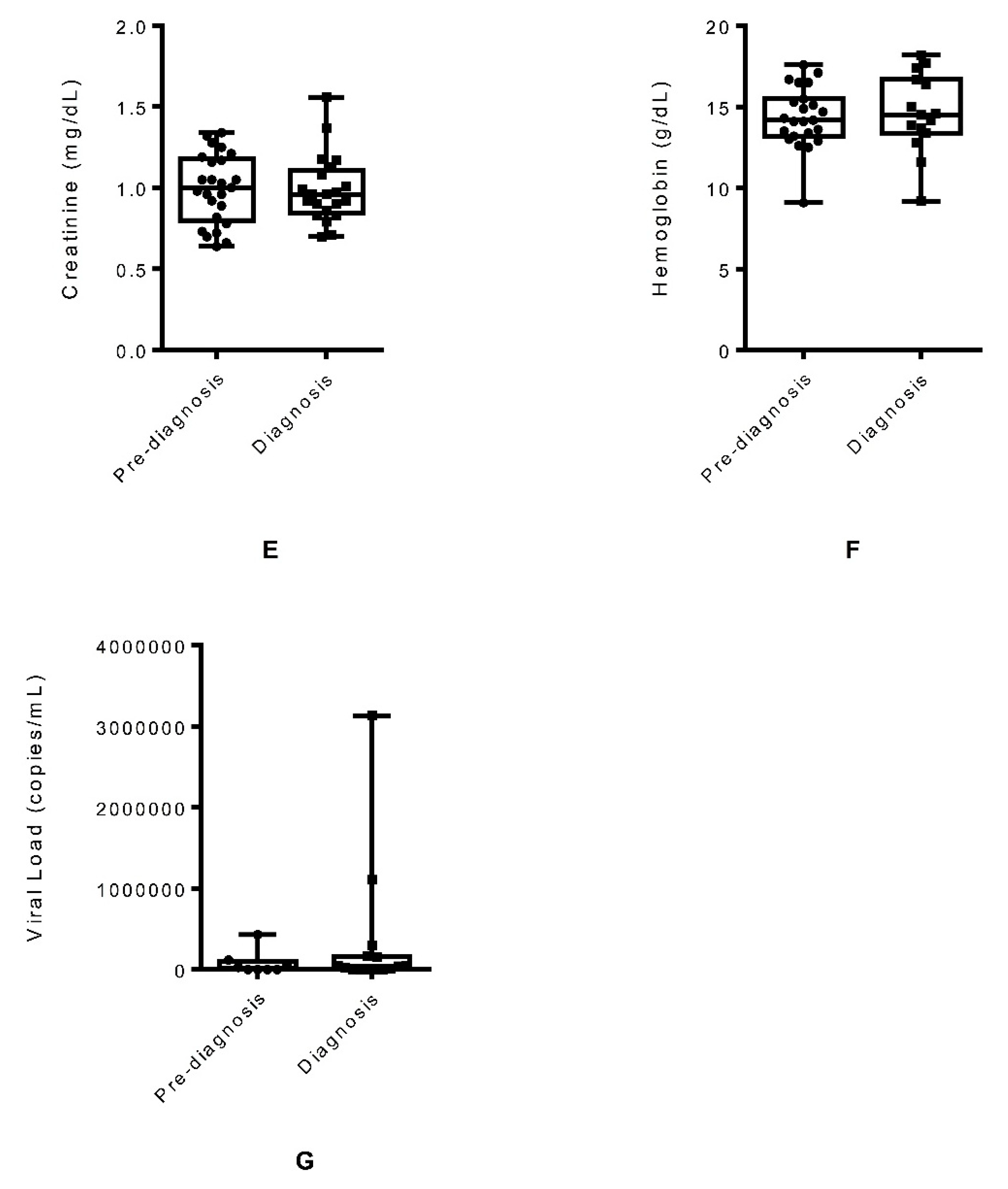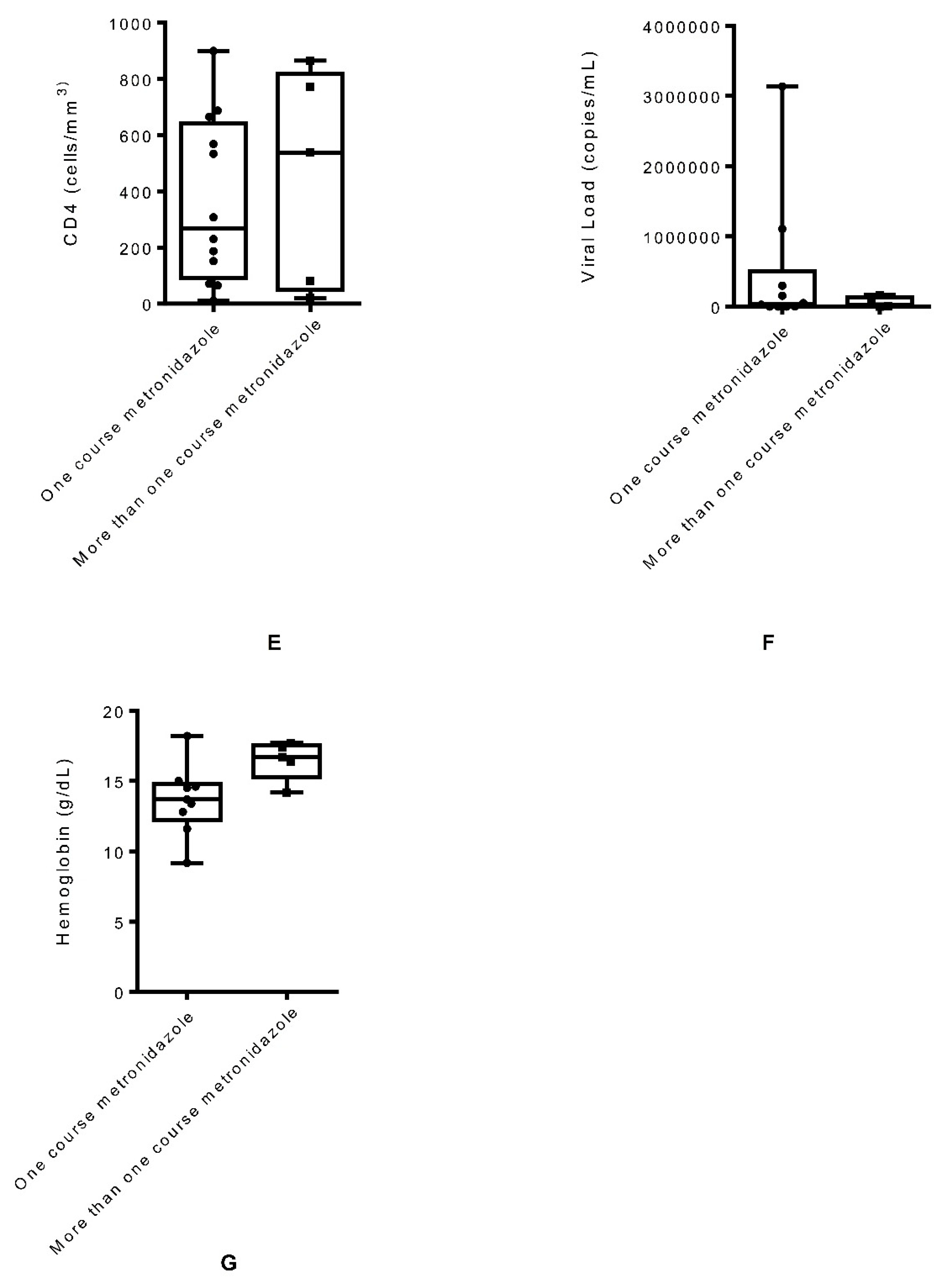Predictors of Failure from Primary Therapy for Giardiasis in San Diego: A Single Institution Retrospective Review
Abstract
1. Introduction
2. Results
2.1. Characteristics of the Study Population
2.2. Clinical Status of Patients
2.3. Association of Giardiasis with Symptomatology
2.4. Primary Treatment of Giardiasis in HIV Patients
2.5. Treatment of Giardiasis with More Than One Course of Metronidazole
2.6. Analysis of Lab Data to Identify Predictors of Multiple Courses of Metronidazole Treatment
3. Discussion
4. Materials and Methods
4.1. Overview
4.2. Patient Selection
4.3. List of Inclusion Criteria
- >18 years old
- HIV infected
- Giardiasis case definition by the following criteria:
- Giardia cysts or trophozoites detected in stool by microscopic examination of wet mounts
- OR Giardia cysts or trophozoites identified by trichrome smear of concentrated stools
- OR positive stool PCR for Giardia
4.4. Data Collection
- Verify inclusion criteria at the time of diagnosis of Giardia
- Demographic data at the time of diagnosis of Giardia
- Travel history at the time of diagnosis and up to 90 days after diagnosis
- Clinical data at the time of diagnosis and up to 90 days after diagnosis
- Physical exam at the time of diagnosis and up to 90 days after diagnosis
- Lab data including microbiology, CD4, HIV viral load at the time of diagnosis and up to 90 days after diagnosis
- Medications including antibiotics, antiretroviral therapy (ART) at the time of diagnosis and up to 90 days after diagnosis
4.5. Statistical Methods
4.6. Compliance with Ethics Guidelines
5. Conclusions
Author Contributions
Acknowledgments
Conflicts of Interest
References
- Torgerson, P.R.; Devleesschauwer, B.; Praet, N.; Speybroeck, N.; Willingham, A.L.; Kasuga, F.; Rokni, M.B.; Zhou, X.N.; Fevre, E.M.; Sripa, B.; et al. World Health Organization Estimates of the Global and Regional Disease Burden of 11 Foodborne Parasitic Diseases, 2010: A Data Synthesis. PLoS Med. 2015, 12, 1001920. [Google Scholar] [CrossRef] [PubMed]
- Scallan, E.; Hoekstra, R.M.; Angulo, F.J.; Tauxe, R.V.; Widdowson, M.A.; Roy, S.L.; Jones, J.L.; Griffin, P.M. Foodborne illness acquired in the United States—Major pathogens. Emerg. Infect. Dis. 2011, 17, 7–15. [Google Scholar] [CrossRef] [PubMed]
- Gardner, T.B.; Hill, D.R. Treatment of giardiasis. Clin. Microbiol. Rev. 2001, 14, 114–128. [Google Scholar] [CrossRef] [PubMed]
- Yoder, J.S.; Harral, C.; Beach, M.J.; Centers for Disease Control and Prevention. Giardiasis surveillance—United States, 2006–2008. MMWR Surveill Summ 2010, 59, 15–25. [Google Scholar] [PubMed]
- Collier, S.A.; Stockman, L.J.; Hicks, L.A.; Garrison, L.E.; Zhou, F.J.; Beach, M.J. Direct healthcare costs of selected diseases primarily or partially transmitted by water. Epidemiol. Infect. 2012, 140, 2003–2013. [Google Scholar] [CrossRef] [PubMed]
- County of San Diego Public Health Services Epidemiology and Immunization Services Branch. Month. Commun. Dis. Rep. 2018, 2, 1–4.
- Savioli, L.; Smith, H.; Thompson, A. Giardia and Cryptosporidium join the ‘Neglected Diseases Initiative’. Trends Parasitol. 2006, 22, 203–208. [Google Scholar] [CrossRef] [PubMed]
- Freeman, C.D.; Klutman, N.E.; Lamp, K.C. Metronidazole. A therapeutic review and update. Drugs 1997, 54, 679–708. [Google Scholar] [CrossRef]
- Sweetman, S.C. Martindale: The Complete Drug Reference, 33rd ed.; Pharmaceutical Press: London, UK, 2002. [Google Scholar]
- Mitelman, F.; Hartley-Asp, B.; Ursing, B. Chromosome aberrations and metronidazole. Lancet 1976, 2, 802. [Google Scholar] [CrossRef]
- Bradley, W.G.; Karlsson, I.J.; Rassol, C.G. Metronidazole neuropathy. Br. Med. J. 1977, 2, 610–611. [Google Scholar] [CrossRef]
- Drugs for Parasitic Infections. Med. Lett. 2013, 11, 1–31.
- Fung, H.B.; Doan, T.L. Tinidazole: A nitroimidazole antiprotozoal agent. Clin. Ther. 2005, 27, 1859–1884. [Google Scholar] [CrossRef] [PubMed]
- Rossignol, J.F.; Ayoub, A.; Ayers, M.S. Treatment of diarrhea caused by Giardia intestinalis and Entamoeba histolytica or E. dispar: A randomized, double-blind, placebo-controlled study of nitazoxanide. J. Infect. Dis. 2001, 184, 381–384. [Google Scholar] [CrossRef] [PubMed]
- Nabarro, L.E.; Lever, R.A.; Armstrong, M.; Chiodini, P.L. Increased incidence of nitroimidazole-refractory giardiasis at the Hospital for Tropical Diseases, London: 2008–2013. Clin. Microbiol. Infect. 2015, 21, 791–796. [Google Scholar] [CrossRef] [PubMed]
- Wright, J.M.; Dunn, L.A.; Upcroft, P.; Upcroft, J.A. Efficacy of antigiardial drugs. Expert Opin. Drug Saf. 2003, 2, 529–541. [Google Scholar] [CrossRef] [PubMed]
- Upcroft, P.; Upcroft, J.A. Drug targets and mechanisms of resistance in the anaerobic protozoa. Clin. Microbiol. Rev. 2001, 14, 150–164. [Google Scholar] [CrossRef] [PubMed]
- Adamu, H.; Wegayehu, T.; Petros, B. High prevalence of diarrhoegenic intestinal parasite infections among non-ART HIV patients in Fitche Hospital, Ethiopia. PLoS ONE 2013, 8, 72634. [Google Scholar] [CrossRef] [PubMed]
- Boaitey, Y.A.; Nkrumah, B.; Idriss, A.; Tay, S.C. Gastrointestinal and urinary tract pathogenic infections among HIV seropositive patients at the Komfo Anokye Teaching Hospital in Ghana. BMC Res. Notes 2012, 5, 454. [Google Scholar] [CrossRef] [PubMed]
- Faria, C.P.; Zanini, G.M.; Dias, G.S.; Sousa, M.D.C. Associations of Giardia lamblia assemblages with HIV infections and symptomatology: HIV virus and assemblage B were they born to each other? Acta Trop. 2017, 172, 80–85. [Google Scholar]
- Sanyaolu, A.O.; Oyibo, W.A.; Fagbenro-Beyioku, A.F.; Gbadegeshin, A.H.; Iriemenam, N.C. Comparative study of entero-parasitic infections among HIV sero-positive and sero-negative patients in Lagos, Nigeria. Acta Trop. 2011, 120, 268–272. [Google Scholar]
- Munoz Gutierrez, J.; Aldasoro, E.; Requena, A.; Comin, A.M.; Pinazo, M.J.; Bardaji, A.; Oliveira, I.; Valls, M.E.; Gascon, J. Refractory giardiasis in Spanish travellers. Travel Med. Infect. Dis. 2013, 11, 126–129. [Google Scholar] [CrossRef] [PubMed]
- Lalle, M.; Hanevik, K. Treatment-refractory giardiasis: Challenges and solutions. Infect. Drug Resist. 2018, 11, 1921–1933. [Google Scholar] [CrossRef] [PubMed]
- Requena-Mendez, A.; Goni, P.; Rubio, E.; Pou, D.; Fumado, V.; Lobez, S.; Aldasoro, E.; Cabezos, J.; Valls, M.E.; Trevino, B.; et al. The Use of Quinacrine in Nitroimidazole-resistant Giardia Duodenalis: An Old Drug for an Emerging Problem. J. Infect. Dis. 2017, 215, 946–953. [Google Scholar] [CrossRef] [PubMed]
- Nash, T.E.; Ohl, C.A.; Thomas, E.; Subramanian, G.; Keiser, P.; Moore, T.A. Treatment of patients with refractory giardiasis. Clin. Infect. Dis. 2001, 33, 22–28. [Google Scholar] [CrossRef] [PubMed]
- Cacopardo, B.; Patamia, I.; Bonaccorso, V.; Di Paola, O.; Bonforte, S.; Brancati, G. Synergic effect of albendazole plus metronidazole association in the treatment of metronidazole-resistant giardiasis. Clin. Ter. 1995, 146, 761–767. [Google Scholar] [PubMed]
- Morch, K.; Hanevik, K.; Robertson, L.J.; Strand, E.A.; Langeland, N. Treatment-ladder and genetic characterisation of parasites in refractory giardiasis after an outbreak in Norway. J. Infect. 2008, 56, 268–273. [Google Scholar] [CrossRef]




| Characteristics | Overall (n = 29) | ||
|---|---|---|---|
| No. | % | Average | |
| Gender | |||
| Male | 29 | 100 | |
| Age (Years) | - | - | 43.17 ± 9.85 |
| Weight (lb) | - | - | 179.86 ± 26.91 |
| Race/Ethnicity | |||
| White | 16 | 55.2 | - |
| Hispanic | 11 | 37.9 | - |
| African American | 1 | 3.4 | - |
| Asian Pacific Islander | 1 | 3.4 | - |
| ART (Antiretroviral Therapy) | |||
| Yes | 29 | 100 | - |
| Characteristics | Overall (n = 29) | |
|---|---|---|
| No. | % | |
| Clinical Symptoms | ||
| Diarrhea | 28 | 96.6 |
| Epigastric Pain | 16 | 55.2 |
| Weight Loss | 15 | 51.7 |
| Bloating | 2 | 6.9 |
| Dyspepsia | 3 | 10.3 |
| Vomiting | 4 | 13.8 |
| Drugs | Overall (n = 29) | Dosing Regimen | Duration | |
|---|---|---|---|---|
| No. | % | |||
| Metronidazole | 25 | 86.2 | 250 mg three times a day (TID), 500 mg two times a day (BID), 500 mg TID | 5–14 days |
| Tinidazole | 2 | 6.9 | 2 g once a day (QD) | 1 day, 7 days |
| Nitazoxanide (Switched from Metronidazole) | 1 | 3.4 | 500 mg BID | 3 days |
| Patient # | Drugs | Dosing Regimen | Duration | Treatment | Follow-Up Testing |
|---|---|---|---|---|---|
| 1 | Metronidazole | 250 mg TID | 5 days | After diagnosis | |
| 500 mg TID | 5 days | 23 days after first course of treatment for diarrhea | 11 months—Stool ova and parasite (O&P) negative | ||
| 2 | Metronidazole | 500 mg TID | 5 days | After diagnosis | |
| 500 mg TID | 5 days | 14 days after first course of treatment for diarrhea | N/A | ||
| 500 mg TID | 15 days | 7 days after second course of treatment | Stool O&P negative | ||
| 3 | Metronidazole | 500 mg TID | 14 days | After diagnosis | |
| 500 mg TID | 10 days | 3 months after first course of treatment for diarrhea | Stool O&P negative | ||
| 4 | Metronidazole | 500 mg TID | 7 days | After diagnosis | |
| 500 mg BID | 7 days | One year after first course of treatment for diarrhea | Stool PCR positive | ||
| 500 mg TID | 5 days | One year and three months after second course of treatment | N/A | ||
| 5 | Metronidazole | 250 mg TID | 7 days | After diagnosis | |
| 250 mg TID | 81 days | Three and a half months after first course of treatment for diarrhea until resolution | N/A | ||
| 6 | Metronidazole | 500 mg TID | 5 days | After diagnosis | |
| 500 mg BID | 120 days | 13 months and 10 days after first course of treatment for diarrhea | N/A | ||
| 7 | Metronidazole | 250 mg TID | 7 days | After diagnosis | |
| 250 mg TID | 7 days | One month after first course of treatment | Stool PCR positive | ||
| Nitazoxanide | 500 mg BID | 4 days | 4 days after second course of treatment | ||
| Metronidazole | 500 mg TID | 10 days | One month 10 days after third course of treatment | Stool PCR positive | |
| Tinidazole | 2 g QD | 1 day | 4 days after fourth course of treatment | N/A |
© 2019 by the authors. Licensee MDPI, Basel, Switzerland. This article is an open access article distributed under the terms and conditions of the Creative Commons Attribution (CC BY) license (http://creativecommons.org/licenses/by/4.0/).
Share and Cite
Debnath, A.; Reed, S.L.; Morris, S.R. Predictors of Failure from Primary Therapy for Giardiasis in San Diego: A Single Institution Retrospective Review. Pathogens 2019, 8, 165. https://doi.org/10.3390/pathogens8040165
Debnath A, Reed SL, Morris SR. Predictors of Failure from Primary Therapy for Giardiasis in San Diego: A Single Institution Retrospective Review. Pathogens. 2019; 8(4):165. https://doi.org/10.3390/pathogens8040165
Chicago/Turabian StyleDebnath, Anjan, Sharon L. Reed, and Sheldon R. Morris. 2019. "Predictors of Failure from Primary Therapy for Giardiasis in San Diego: A Single Institution Retrospective Review" Pathogens 8, no. 4: 165. https://doi.org/10.3390/pathogens8040165
APA StyleDebnath, A., Reed, S. L., & Morris, S. R. (2019). Predictors of Failure from Primary Therapy for Giardiasis in San Diego: A Single Institution Retrospective Review. Pathogens, 8(4), 165. https://doi.org/10.3390/pathogens8040165






